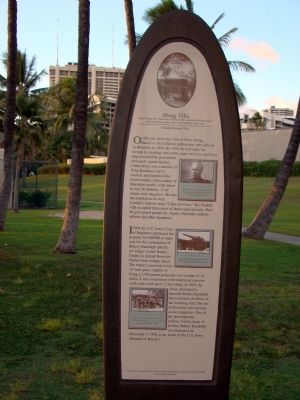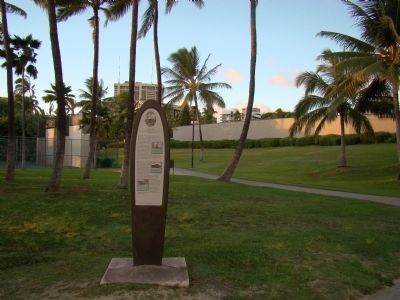Waikiki in Honolulu in Honolulu County, Hawaii — Hawaiian Island Archipelago (Pacific Ocean)
Afong Villa
Waikīkī Historic Trail
In 1904 the U.S. Army Corps of Engineers purchased the property for $28,000 to make way for the construction of Battery Randolph and the no-longer-extant Battery Dudley to defend Honolulu Harbor from foreign attack. The battery consisted of two 14-inch guns, capable of firing a 1,560 pound projectile over a range of 14 miles. It was constructed with reinforced concrete walls and a roof up to 12 feet thick. In 1969, the Army attempted to demolish Battery Randolph, but it resisted all efforts of the wrecking ball. The use of dynamite was rejected as too dangerous. One of the last important military fortifications of its time. Battery Randolph was dedicated on December 7, 1976 as the home of the U.S. Army Museum of Hawai‘i.
Erected by Vision Team of Kapahulu, Diamond Head, and Waikiki.
Topics. This historical marker is listed in these topic lists: Asian Americans • Forts and Castles • Industry & Commerce • Settlements & Settlers. A significant historical month for this entry is December 1540.
Location. 21° 16.683′ N, 157° 50.017′ W. Marker is in Honolulu, Hawaii, in Honolulu County. It is in Waikiki. Marker can be reached from the intersection of Kalia Road and Saratoga Road. It is just off the beachwalk on the Diamond Head edge of the Fort DeRussy grounds, near the Waikiki Shore Hotel. Touch for map. Marker is in this post office area: Honolulu HI 96815, United States of America. Touch for directions.
Other nearby markers. At least 8 other markers are within walking distance of this marker. U.S. 105mm Howitzer M3 (about 300 feet away, measured in a direct line); Japanese Type 1 (1941) (about 300 feet away); Japanese Light Tank (about 300 feet away); Kawehewehe (about 300 feet away); U.S. Light Tank, M24 (about 400 feet away); Monarchy Cannon (about 400 feet away); U.S. Prefabricated Pill Box (about 400 feet away); Mahiole (about 700 feet away). Touch for a list and map of all markers in Honolulu.
More about this marker. There are four photographs reproduced on the marker with the following captions: “Chun Afong, the ‘Merchant of the Sandalwood Mountains,’ sponsored many gala events at his Waikiki beach villa.” “After becoming a successful businessman, Chun Afong married Julia Fayerweather, a Hawaiian-Caucasian of chiefly descent.” “Completed in 1911, Battery Randolph’s guns were built to defend Honolulu Harbor from attack.” And “Coastal Artillery Units fired practice rounds at Ft. DeRussy, but its guns were never used in actual defense of O‘ahu. Photo ca. 1915.”
Also see . . . Merchant Prince of the Sandalwood Mountains: Afong and the Chinese in Hawaii. 1997 book by Bob Dye. “Afong not only went to the right places at the right times, he prospered in businesses that bankrupted others. Where other entrepreneurs saw Hawaii to be at the periphery of empire, Afong saw the Islands as the strategic center of a dynamic East-West market, free from the costly revolutions and wars that plagued other regions.” (Submitted on November 16, 2008.)
Additional keywords. Drug trade
Credits. This page was last revised on February 10, 2023. It was originally submitted on November 16, 2008, by J. J. Prats of Powell, Ohio. This page has been viewed 2,856 times since then and 77 times this year. Last updated on November 20, 2011, by Richard E. Miller of Oxon Hill, Maryland. Photos: 1, 2. submitted on November 16, 2008, by J. J. Prats of Powell, Ohio. • Bill Pfingsten was the editor who published this page.

